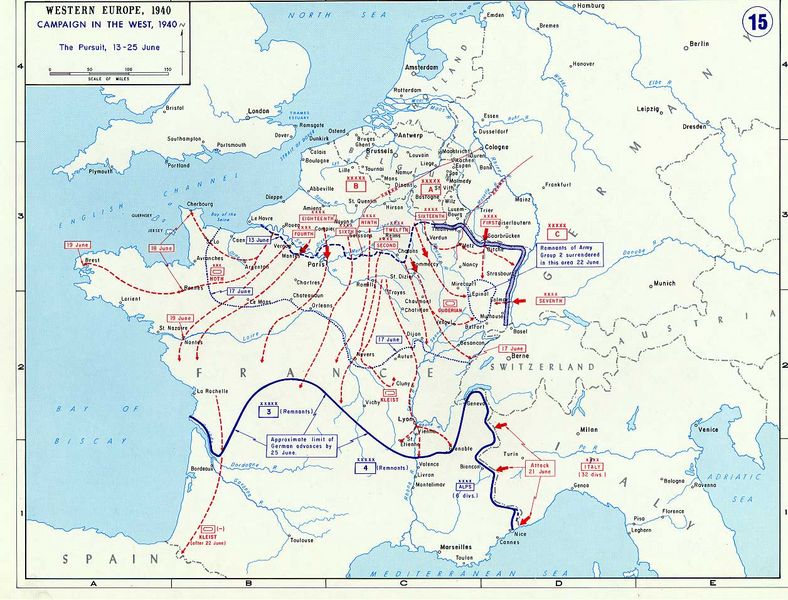
Tankettes - a forgotten episode in the development of armored forces
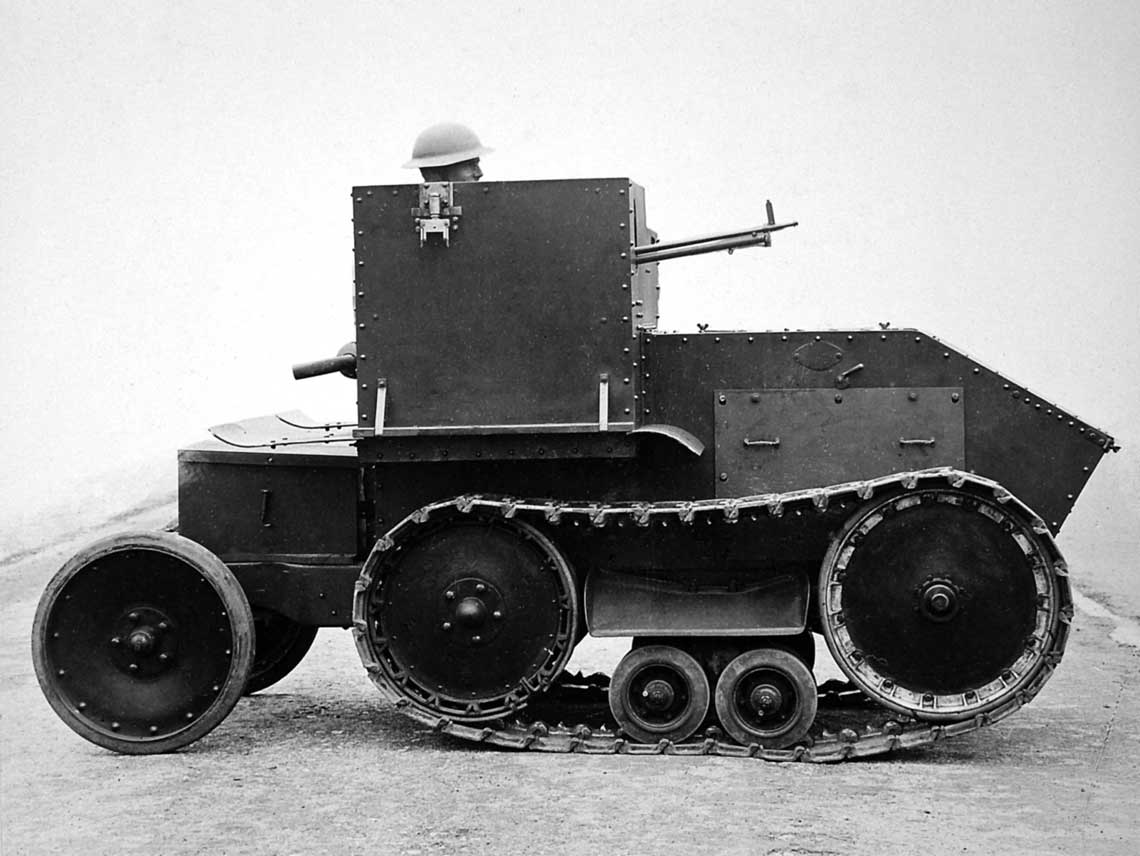
The first innovative Morris-Martel One Man Tankette was built in the amount of eight copies. Its development was discontinued in favor of a similar Carden-Loyd design.
A tankette is a small fighting vehicle, usually armed only with machine guns. It is sometimes said that this is a small tank, lighter than light tanks. However, in fact, this was the first attempt to mechanize the infantry, providing them with a vehicle that allows them to accompany tanks in the attack. However, in many countries attempts were made to use these vehicles interchangeably with light tanks - with some damage. Therefore, this direction of development of wedges was quickly abandoned. However, the development of these machines in a different role continues to this day.
The birthplace of the tankette is Great Britain, the birthplace of the tank, which appeared on the battlefields of the First World War in 1916. Great Britain is more than the middle of the interwar period, i.e. until 1931-1933 the processes of mechanization of the ground forces and the development of the doctrine of the use of armored forces and speeds. Later, in the XNUMXs, and especially in the second half of the decade, it was overtaken by Germany and the USSR.
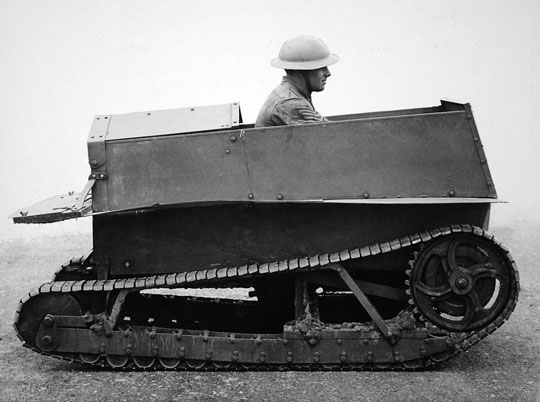
The Carden-Loyd One Man Tankette is the first model of a single-seat tankette, prepared by John Carden and Vivian Loyd (two copies were built, differing in details).
Immediately after the First World War, Britain had five infantry divisions (three infantry brigades and divisional artillery each), twenty cavalry regiments (including six independent, six made up three cavalry brigades and another eight stationed outside the British Isles) and four battalions tanks. However, already in the XNUMXs there were extensive discussions about the mechanization of the ground forces. The term "mechanization" was understood quite broadly - as the introduction of internal combustion engines into the army, both in the form of cars and, for example, chainsaws in engineering or diesel power generators. All this was supposed to increase the combat effectiveness of the troops and, above all, increase their mobility on the battlefield. The maneuver, despite the sad experience of the First World War, was considered decisive for the success of any action at the tactical, operational or even strategic level. One could say "despite", but one could also say that it was thanks to the experience of the First World War that the role of maneuver in combat took such a prominent place. It has been found out that positional warfare, strategically being a war of destruction and depletion of resources, and from a human point of view, just trench "junk", does not lead to a decisive resolution of the conflict. Great Britain could not afford to wage a war of annihilation (i.e. positional), since the continental rivals of the British had more material resources and manpower at their disposal, which means that British resources would have been exhausted earlier.
Therefore, the maneuver was necessary, and it was necessary at all costs to find ways to impose it on a potential enemy. It was necessary to develop concepts for the passage (forcing) of maneuver actions and the concept of maneuver war itself. In the UK, a lot of theoretical and practical work has been carried out on this issue. In September 1925, for the first time since 1914, major bilateral tactical maneuvers involving several divisions were held. During these maneuvers, a large mechanized formation called the Mobile Force was improvised, consisting of two cavalry brigades and a truck-borne infantry brigade. The maneuverability of cavalry and infantry turned out to be so different that although the infantry on trucks initially moved forward, in the future they had to be blown up quite far from the battlefield. As a result, the infantrymen arrived at the battlefield when it had already ended.

Carden-Loyd Mk III tankette, an evolution of the Mk II with additional drop-down wheels like the Mk I* (one built).
The conclusion from the exercises was quite simple: the British troops had the technical means of mechanized maneuver, but the lack of experience in the use of technical means (in combination with horse-drawn traction) meant that maneuvering by formations of troops was unsuccessful. It was necessary to develop an exercise on the movement of troops by road, so that this maneuver would go smoothly and that the units brought up would approach the battlefield in the right order, having all the necessary means of combat and combat cover. Another issue is the synchronization of the maneuver of infantry groups with artillery (and sapper, communications, reconnaissance, anti-aircraft elements, etc.), with armored formations moving on tracks, and therefore often off the roads accessible to wheeled vehicles. Such conclusions were drawn from the great maneuvers of 1925. From that moment on, conceptual work was carried out on the question of the mobility of troops in the era of their mechanization.
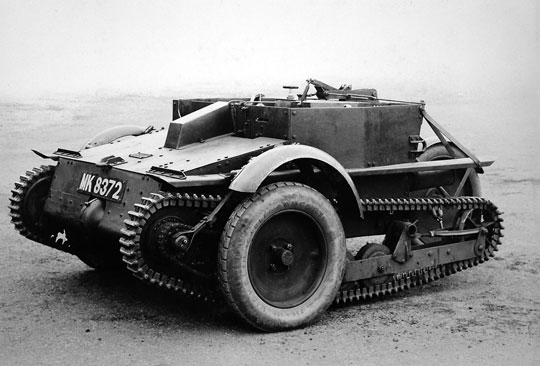
The Carden-Loyd Mk IV is a two-man tankette based on previous models, without a roof or turret, with four road wheels on each side and additional drop wheels.
In May 1927, the world's first mechanized brigade was created in Great Britain. It was formed on the basis of the 7th Infantry Brigade, from which - as an element of motorized infantry - the 2nd Battalion of the Cheshire Regiment was detached. Remaining forces of the brigade: Flanking Reconnaissance Group (wing reconnaissance group) consisting of two armored car companies from the battalion of the 3rd Battalion of the Royal Tank Corps (RTK); The main reconnaissance group is two companies, one with 8 Carden Loyd tankettes and the other with 8 Morris-Martel tankettes from the 3rd RTC battalion; 5th RTC Battalion with 48 Vickers Medium Mark I tanks; Mechanized Machine Gun Battalion - 2nd Somerset Light Infantry Battalion with Vickers heavy machine gun, transported on Crossley-Kégresse half-tracks and 6-wheeled Morris trucks; 9th Field Brigade, Royal Artillery, with three batteries of 18-pounder QF field guns and 114,3 mm howitzers, two of which are towed by Dragon tractors and one is towed by Crossley-Kégresse half-tracks; 20th Battery, 9th Field Brigade, Royal Artillery - Brich Gun experimental battery; a light battery of 94 mm mountain howitzers carried by Burford-Kégresse half-track tractors; Mechanized field company of the Royal Engineers on 6-wheeled Morris vehicles. The commander of this mechanized force was Colonel Robert J. Collins, who was also commander of the 7th Infantry Brigade stationed in the same garrison at Camp Tidworth on Salisbury Plain.
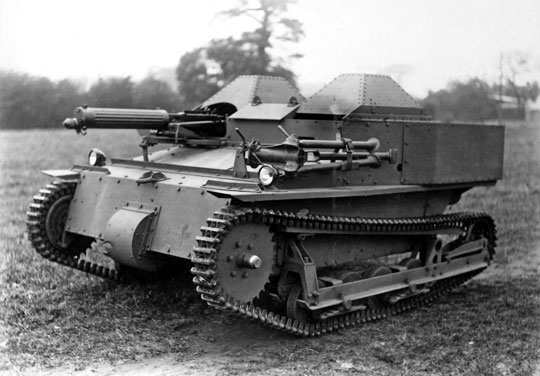
The Carden-Loyd Mk VI is the first successful tankette to become a classic design in its class that others have followed.
The first exercises of the new formation in the 3rd Infantry Division, under the command of Major W. John Burnett-Stewart, showed mixed results. It was difficult to synchronize the maneuvers of different elements by vehicles with different properties.
The actions of experienced mechanized troops showed that attempts to simply mechanize existing infantry formations, together with the artillery attached to them and support forces in the form of reconnaissance units, sappers, communications and services, do not bring positive results. Mechanized troops must be formed on new principles and manned adequately to the combat capabilities of the combined forces of tanks, motorized infantry, mechanized artillery, and motorized services, but in quantities matched adequately to the needs of mobile warfare.
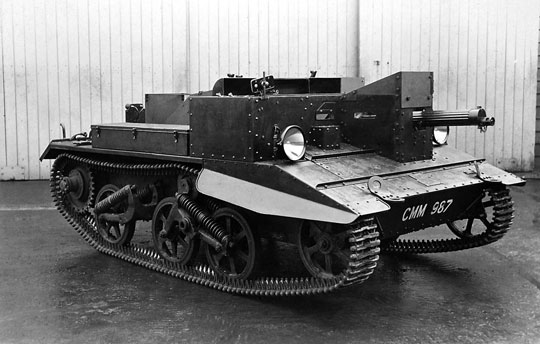
From Carden-Loyd tankettes comes the tracked light armored personnel carrier Universal Carrier, which was the most numerous Allied armored vehicle in World War II.
Tankitki Martella and Carden-Loyda
However, not everyone wanted to mechanize the army in this form. They believed that the appearance of a tank on the battlefield completely changes its image. One of the most able officers of the later Royal Mechanized Corps, Giffard Le Quen Martel, captain of sappers in 1916 (later Lieutenant-General Sir G. C. Martel; 10 October 1889 - 3 September 1958), held a completely different view. .
GQ Martel was the son of Brigadier General Charles Philip Martel who was in charge of all government defense factories including ROF at Woolwich. GQ Martel graduated from the Royal Military Academy, Woolwich in 1908 and became a second lieutenant of engineers. During the First World War, he fought in the engineer-sapper army, being engaged, among other things, in the construction of fortifications and their overcoming by tanks. In 1916, he wrote a memorandum called "The Tank Army" in which he proposed re-equipping the entire army with armored vehicles. In 1917-1918, Brig. Fuller when drawing up plans for the use of tanks in subsequent offensives. After the war, he served in the engineering troops, but the interest in tanks remained. In the experimental mechanized brigade at Camp Tidworth, he commanded a mechanized company of sappers. Already in the first half of the XNUMXs, he experimented with the development of tank bridges, but he was still interested in tanks. With the army on a tight budget, Martel turned to the development of small, single-man tankettes that could be used to mechanize all infantry and cavalry.
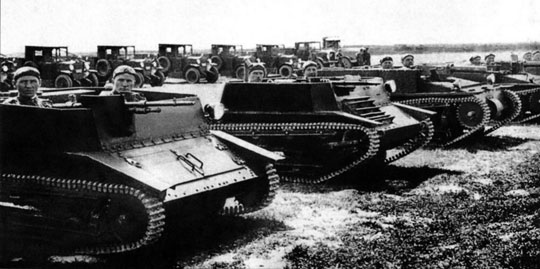
Prototypes of the Polish tankettes (left) TK-2 and TK-1 and the British Carden-Loyd Mk VI with a modified undercarriage purchased for testing and the original machine of this type; probably 1930
Here it is worth going back to the 1916 memorandum and seeing what GQ Martel offered then. Well, he envisioned that all ground forces should be converted into one big armored force. He believed that a lone soldier without armor had no chance of surviving on a battlefield dominated by machine guns and rapid-fire artillery. Therefore, he decided that the warhead should be equipped with three main categories of tanks. He used a naval analogy - only ships fought on the seas, most often armored, but a specific analogue of the infantry, i.e. there were no soldiers by swimming or in small boats. Virtually all combat vehicles of naval warfare since the late XNUMXth century have been mechanically powered steel monsters of various sizes (mostly steam due to their size).
Therefore, GQ Martel decided that in an era of lightning-fast firepower from machine guns and rapid-fire sniper guns, all ground forces should switch to ships-like vehicles.
GQ Martel offers three categories of combat vehicles: destroyer tanks, battleship tanks and torpedo tanks (cruising tanks).
The category of non-combat vehicles should include supply tanks, i.e. armored vehicles for transporting ammunition, fuel, spare parts and other materials to the battlefield.
With regard to battle tanks, the main quantitative mass was to be fighter tanks. Of course, they were not supposed to be tank destroyers, as the name might suggest - it's just an analogy with naval warfare. It was supposed to be a light tank armed with machine guns, actually used for infantry mechanization. The tank destroyer units were supposed to replace the classic infantry and cavalry and perform the following tasks: in the "cavalry" area - reconnaissance, covering the wing and carrying out corpses behind enemy lines, in the "infantry" area - taking the area and patrolling the occupied areas, fighting the same type of formations the enemy, interception and retention of important terrain objects, bases and warehouses of the enemy, as well as cover for battleship tanks.
Battleship tanks were supposed to form the main striking force and perform the functions characteristic of armored forces, and partly of artillery. They were supposed to be divided into three different categories: heavy with low speed, but powerful armor and armament in the form of a 152-mm gun, medium with weaker armor and armor, but with greater speed, and light - fast, although the least armored and armed. The latter were supposed to conduct reconnaissance behind armored formations, as well as pursue and destroy enemy tank destroyers. And finally, "torpedo tanks", that is, battleship tank destroyers, with heavy weapons, but less armor for greater speed. The torpedo tanks were supposed to catch up with the tanks of the battleships, destroy them, and get out of range of their weapons before they themselves were destroyed. Thus, in naval warfare, they would be distant counterparts to heavy cruisers; in a land war, an analogy arises with the later American concept of tank destroyers. G.K. Martel assumed that the "torpedo tank" in the future could be armed with a kind of rocket launcher, which would be more effective in hitting armored targets. The concept of full mechanization of the army in the sense of equipping troops only with armored vehicles also attracted Colonel W. (later General) John F. C. Fuller, the most famous theorist of the use of British armored forces.
In the course of his later service, Captain and later Major Giffard Le Ken Martel promoted the theory of building tank destroyers, i.e. very cheap, small, 1/2-seat armored vehicles armed with machine guns, which were to replace the classic infantry and cavalry. When, in 1922, Herbert Austin demonstrated to everyone his tiny cheap car with a 7 hp engine. (hence the name Austin Seven), GQ Martel began to promote the concept of such a tank.
In 1924, he even built a prototype of such a car in his own garage, using simple steel plates and parts from various cars. He himself was a good mechanic and, as a sapper, had an appropriate engineering education. At first, he presented his car to his military colleagues more with fun than with interest, but soon the idea found fertile ground. In January 1924, for the first time in history, a government of the left-wing Labor Party was formed in Great Britain, led by Ramsay MacDonald. True, his government lasted only until the end of the year, but the machine started working. Two car companies - Morris Motor Company of Cowley, led by William R. Morris, Lord Nuffield, and Crossley Motors of Gorton outside Manchester - were tasked with building cars based on the concept and design of GQ Martel.
A total of eight Morris-Martel tankettes were built, using tracked chassis from Roadless Traction Ltd. and a Morris engine with a power of 16 hp, which allowed the car to reach a speed of 45 km / h. In the single-seat version, the vehicle was supposed to be armed with a machine gun, and in the double-seat version, a 47-mm short-barreled gun was even planned. The car was exposed from above and had a relatively high silhouette. The only Crossley prototype was powered by a 27 hp four-cylinder Crossley engine. and had a caterpillar undercarriage of the Kègresse system. This prototype was withdrawn in 1932 and given to the Royal Military College of Science as an exhibit. However, it has not survived to this day. Both machines - from both Morris and Crossley - were half-tracked, as they both had wheels to drive the car behind the tracked undercarriage. This simplified the design of the car.
The military didn't like the Martel design, so I settled on these eight Morris-Martel wedges. The concept itself, however, was very attractive due to the low price of similar vehicles. This gave hope for the entry into service of a large number of "tanks" at low costs for their maintenance and purchase. However, the preferred solution was proposed by a professional designer, engineer John Valentine Cardin.
John Valentine Cardin (1892-1935) was a gifted self-taught engineer. During the First World War, he served in the Guard Corps of the Army Corps, operating the Holt tracked tractors used by the British Army to tow heavy guns and supply trailers. During his military service, he rose to the rank of captain. After the war, he created his own company producing very small cars in small series, but already in 1922 (or 1923) he met Vivian Loyd, with whom they decided to produce small tracked vehicles for the army - as tractors or for other uses. In 1924 they founded Carden-Loyd Tractors Ltd. in Chertsey on the west side of London, east of Farnborough. In March 1928, Vickers-Armstrong, a large concern, bought their company, and John Carden became the technical director of the Vickers Panzer Division. Vickers already has the most famous and most massive tankette of the Carden-Loyd duo, Mk VI; A 6-ton Vickers E tank was also created, which was widely exported to many countries and licensed in Poland (its long-term development is 7TP) or in the USSR (T-26). The latest development of John Carden was the VA D50 light tracked vehicle, created directly on the basis of the Mk VI tankette and which was the prototype of the Bren Carrier light aircraft carrier. On December 10, 1935, John Cardin died in a plane crash on the Belgian airliner Sabena.
His partner Vivian Loyd (1894-1972) had a secondary education and served in the British artillery during the First World War. Immediately after the war, he also built small cars in small series before joining the Carden-Loyd company. He also became a tank builder at Vickers. With Cardin, he was the creator of the Bren Carrier family and later Universal Carrier. In 1938, he left to start his own company, Vivian Loyd & Co., which made slightly larger Loyd Carrier crawler tractors; about 26 were built during World War II (mostly by other companies under license from Loyd).
The first tankette was built at the Cardin-Loyd factory in the winter of 1925-1926. It was a lightly armored hull with a rear engine behind the driver, with tracks attached to the sides. The small road wheels were not cushioned, and the top of the caterpillar slid on metal sliders. Steering was provided by one wheel mounted in the rear fuselage, between the tracks. Three prototypes were built, and soon one machine was built in an improved version of the Mk I *. In this car, it was possible to install additional wheels on the side, which were driven by a chain from the front drive axle. Thanks to them, the car could move on three wheels - two driving wheels in front and one small steering wheel in the back. This made it possible to keep tracks on the roads when leaving the battlefield and increase mobility on the beaten paths. In fact, it was a wheeled-tracked tank. The Mk I and Mk I* were single-seat vehicles, similar to the Mk II developed at the end of 1926, which featured the use of road wheels suspended from suspension arms, damped by springs. A variant of this machine with the ability to install wheels according to the Mk I * scheme was called the Mk III. The prototype underwent intensive testing in 1927. However, a two-seat tankette version with a lower hull soon appeared. Two crew members of the car were placed on either side of the engine, thanks to which the car acquired a characteristic, square shape with a length similar to the width of the car. One crew member controlled the tankette, and the other served its armament in the form of a machine gun. The track-mounted undercarriage was more polished, but the steering was still one wheel at the rear. The engine drove the front gears, which transferred traction to the tracks. It was also possible to attach additional wheels to the side, to which power was transmitted through a chain from the front drive wheels - for driving on dirt roads. The car appeared at the end of 1927, and at the beginning of 1928, eight serial Mk IV vehicles entered the company of the 3rd tank battalion, which was part of the Experimental Mechanized Brigade. These are the first Carden-Loyd wedges purchased by the military and put into service.
The 1928 Mk V prototype was the last to be developed by Carden-Loyd Tractors Ltd. It differed from previous cars with a large steering wheel and extended tracks. However, it was not purchased by the military.
Carden-Loyd under the Vickers brand
Vickers has already developed a new tankette prototype, the Mk V*. The main difference was a radical change in the suspension. Large road wheels on rubber mounts were used, suspended in pairs on bogies with common shock absorption with a horizontal leaf spring. This solution turned out to be simple and effective. The car was built in nine copies, but the next version became a breakthrough. Instead of a steering wheel at the rear, it uses side clutches to provide differential power transfer to the tracks. Thus, the turn of the machine was carried out as on modern tracked combat vehicles - due to the different speeds of both tracks or by stopping one of the tracks. The wagon could not move on wheels, there was only a caterpillar version. The drive was a very reliable Ford engine, derived from the famous Model T, with a power of 22,5 hp. The fuel supply in the tank was 45 liters, which was enough to travel about 160 km. The maximum speed was 50 km / h. The armament of the vehicle was located on the right: it was a 7,7 mm air-cooled Lewis machine gun or a water-cooled Vickers rifle.
the same caliber.
It was this machine that went into mass production. In two large batches of 162 and 104 copies, a total of 266 vehicles were delivered in the basic version with prototypes and specialized options, and 325 were produced. Some of these vehicles were produced by the state-owned Woolwich Arsenal plant. Vickers sold single Mk VI wedges with a production license to many countries (Fiat Ansaldo in Italy, Polskie Zakłady Inżynieryjne in Poland, USSR state industry, Škoda in Czechoslovakia, Latil in France). The largest foreign recipient of British-built vehicles was Thailand, which received 30 Mk VI and 30 Mk VIb vehicles. Bolivia, Chile, Czechoslovakia, Japan and Portugal each purchased 5 vehicles built in the UK.

Soviet heavy tank T-35 surrounded by tankettes (light reckless tanks) T-27. Replaced by T-37 and T-38 amphibious reconnaissance tanks with armament placed in a rotating turret.
In the UK, the Vickers Carden-Loyd Mk VI tankettes were used primarily in reconnaissance units. However, on their basis, a light tank Mk I was created, developed in subsequent versions in the 1682s. It had a tankette suspension developed as a successor to the Mk VI from which the Scout Carrier, Bren Carrier and Universal Carrier families of armored personnel carriers descended, a closed top hull and a rotating turret with a machine gun or machine gun. heavy machine gun. The last variant of the Mk VI light tank was built in the number of XNUMX vehicles that were used in combat during the initial phase of World War II.
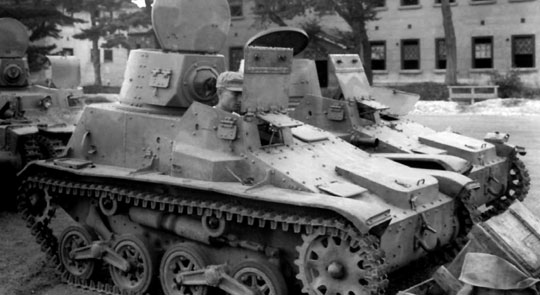
Japanese Type 94 tankettes were used during the Sino-Japanese War and the first period of World War II. It was replaced by the Type 97 with a 37 mm gun, produced until 1942.
Summation
In most countries, the licensed production of wedges was not directly carried out, but their own modifications were introduced, often quite radically changing the design of the machine. The Italians built 25 vehicles exactly according to Carden-Loyd's plans under the name CV 29, followed by about 2700 CV 33 vehicles and upgraded CV 35 vehicles - the latter with two machine guns. After purchasing five Carden-Loyd Mk VI machines, Japan decided to develop its own similar design. The car was developed by the Ishikawajima Motorcar Manufacturing Company (now Isuzu Motors), who then built 167 Type 92s using many Carden-Loyd components. Their development was a machine with a covered hull and a single turret with a single 6,5 mm machine gun manufactured by Hino Motors as the Type 94; 823 pieces were created.
In Czechoslovakia in 1932, the ČKD (Českomoravská Kolben-Daněk) company from Prague was developing a car under license from Carden-Loyd. The vehicle known as the Tančík vz. 33 (wedge wz. 33). After testing the purchased Carden-Loyd Mk VI, the Czechs came to the conclusion that a lot of changes should be made to the machines. Four prototypes of the improved vz. 33 with 30 hp Prague engines. were tested in 1932, and in 1933 mass production of 70 machines of this type began. They were used during World War II
the Slovak army.
In Poland, from August 1931, the army began to receive TK-3 wedges. They were preceded by two prototypes, the TK-1 and TK-2, more closely related to the original Carden-Loyd. TK-3 already had a covered fighting compartment and many other improvements introduced in our country. In total, by 1933, about 300 vehicles of this type were built (including 18 TKF, as well as prototypes of the TKV and the TKD self-propelled anti-tank gun), and then, in 1934-1936, significantly 280 modified vehicles were delivered to the Polish Army TKS with improved armor and a power plant in the form of a Polish Fiat 122B engine with 46 hp.
Large-scale production of machines based on Carden-Loyd solutions was carried out in the USSR under the name T-27 - although only slightly more than the production in Italy and not the largest in the world. In the USSR, the original design was also modified by increasing the car, improving the power transmission and introducing its own 40 hp GAZ AA engine. Armament consisted of one 7,62 mm DT machine gun. Production was carried out in 1931-1933 at plant No. 37 in Moscow and at the GAZ plant in Gorki; A total of 3155 T-27 vehicles were built and an additional 187 in the ChT-27 variant, in which the machine gun was replaced with a flamethrower. These trucks remained in operation until the start of the USSR's participation in World War II, that is, until the summer and autumn of 1941. However, at that time they were mainly used as tractors for light firearms and as communication vehicles.
France boasts the largest production of tankettes in the world. Here, too, it was decided to develop a small tracked vehicle based on the technical solutions of Carden-Loyd. However, it was decided to design the car so as not to pay the British for a license. Renault, Citroen and Brandt entered the competition for a new car, but finally, in 1931, the Renault UE design with a Renault UT two-axle crawler trailer was chosen for mass production. The problem, however, was that while in all other countries native varieties of Carden-Loyd tankettes were treated as combat vehicles (intended primarily for reconnaissance units, although in the USSR and Italy they were treated as a cheap way to creation of armored support for infantry units), it was in France from the very beginning that the Renault UE was supposed to be an artillery tractor and an ammunition transport vehicle. It was supposed to tow light guns and mortars used in infantry formations, mainly anti-tank and anti-aircraft guns, as well as mortars. Until 1940, 5168 of these machines were built and an additional 126 under license in Romania. Before the outbreak of hostilities, it was the most massive tankette.
However, the British car, created directly on the basis of Carden-Loyd tankettes, broke absolute popularity records. Interestingly, the captain originally planned the role for him in 1916. Martela - that is, it was a vehicle for transporting infantry, or rather, it was used to mechanize infantry machine gun units, although it was used in a variety of roles: from reconnaissance to a light weapon tractor, combat supply vehicles, medical evacuation, communications, patrolling, etc. . Its beginning goes back to the Vickers-Armstrong D50 prototype, developed by the company itself. He was supposed to be the carrier of a machine gun for infantry support, and in this role - under the name Carrier, Machine-Gun No 1 Mark 1 - the army tested its prototypes. The first production vehicles entered service with the British forces in 1936: Machine Gun Carrier (or Bren Carrier), Cavalry Carrier and Scout Carrier. Slight differences between the vehicles were explained by their intended purpose - as a vehicle for infantry machine-gun units, as a transporter for mechanizing cavalry and as a vehicle for reconnaissance units. However, since the design of these machines was almost identical, the name Universal Carrier appeared in 1940.
In the period from 1934 to 1960, as many as 113 of these vehicles were built at many different factories in Great Britain and Canada, which is an absolute record for armored vehicles in the world in their entire history. These were wagons that massively mechanized the infantry; they were used for many different tasks. It is from such vehicles that post-war, much heavier tracked armored personnel carriers are used to transport infantry and support it on the battlefield. It should not be forgotten that the Universal Carrier was in fact the world's first tracked armored personnel carrier. Today's transporters, of course, are much larger and heavier, but their purpose is identical - to transport infantrymen, protect them as much as possible from enemy fire and provide them with fire support when they go into battle outside the vehicle.
It is generally accepted that wedges are a dead end in the development of armored and mechanized troops. If we treat them like tanks, as a cheap substitute for a combat vehicle (the tankettes include, for example, the German Panzer I light tanks, whose combat value was really low), then yes, it was a dead end in the development of combat vehicles. However, tankettes were not supposed to be typical tanks, which was forgotten by some armies who tried to use them as tank substitutes. These were supposed to be infantry vehicles. Because, according to Fuller, Martel and Liddell-Hart, the infantry had to move and fight in armored vehicles. For "tank destroyers" in 1916, there were tasks that are now performed by motorized infantry on infantry fighting vehicles - almost exactly the same.
See also >>>
TKS reconnaissance tanks

